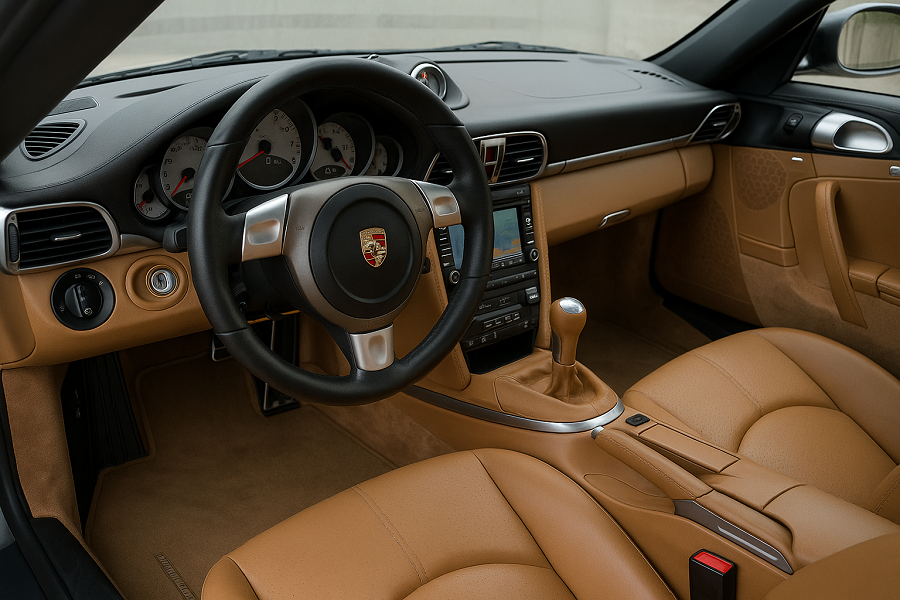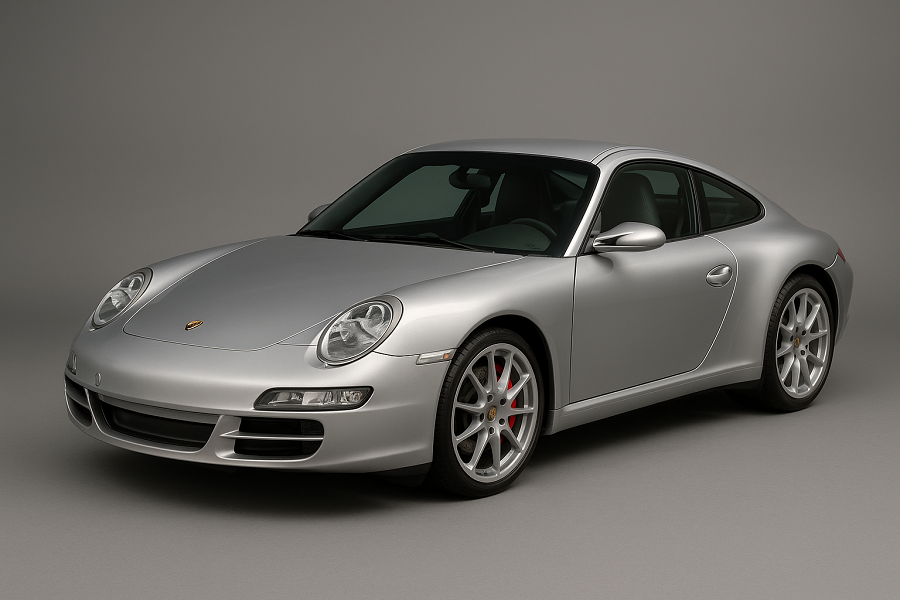Table of Contents
Table of Contents
Introduction: Why the Porsche 997 Is the “Sweet Spot” of Modern 911s
The Porsche 997, produced from 2004 to 2012, is often hailed as the perfect blend of classic charm and modern performance. It retains the raw, analog feel that purists love, thanks to its hydraulic steering and smaller chassis, yet brings in updated tech and refined styling. Compared to earlier models like the 996, the 997 feels more composed and desirable—both as a weekend toy and an investment. Whether you’re eyeing a Carrera, Turbo, or GT3, the 997 generation delivers driving excitement without sacrificing reliability or comfort.
Porsche 997 Model Overview
The Porsche 997 automatic was built in two main phases: the 997.1 (2004–2008) and the 997.2 (2009–2012). While both look similar at first glance, they have key differences. The 997.1 used older engines and a Tiptronic automatic, while the 997.2 introduced direct fuel injection, the quicker PDK transmission, and updated electronics. This generation also brought a sleeker design compared to the 996. Whether you choose Mk1 or Mk2, each has its own character and charm.
997 Variants Explained: Carrera, Turbo, GT Models
The Porsche 997 lineup offered something for every driver—from spirited weekend cruises to high-performance track driving.
Porsche 997 Model Types
| Model Variant | Drivetrain | Engine Size | Notable Features |
|---|---|---|---|
| Carrera | RWD | 3.6L NA | Entry-level, balanced performance |
| Carrera S | RWD | 3.8L NA | More power, sports exhaust |
| Carrera 4 / 4S | AWD | 3.6L / 3.8L NA | All-weather grip, wide-body styling |
| Targa 4 / 4S | AWD | 3.6L / 3.8L NA | Retractable glass roof, Carrera features |
| Turbo / Turbo S | AWD | 3.6L / 3.8L Turbo | High-output, all-weather supercar |
| porsche 997 gt3 / GT3 RS | RWD | 3.6L / 3.8L NA | Track-focused, naturally aspirated |
| GT2 / GT2 RS | RWD | 3.6L Turbo | Rare, extreme performance, RWD only |
| GTS | RWD or AWD | 3.8L NA | Enthusiast blend of power and comfort |
Engine, Performance & Transmission Options
Whether you crave smooth cruising or aggressive acceleration, the porsche 997 turbo delivers.
- 997.1 Engines:
- 3.6L (325 hp) and 3.8L (355 hp), port-injected
- Known for character, but subject to IMS bearing concerns
- 997.2 Engines:
- DFI engines with improved reliability (345–408 hp)
- Better fuel economy, no IMS bearing issue
- Transmissions:
- 5-speed Tiptronic (997.1 automatic)
- 7-speed PDK (997.2 automatic – faster, sportier)
- 6-speed manual (standard in all variants)
Tip: Many enthusiasts prefer the manual or PDK over Tiptronic for engagement and speed.

Interior, Features & Trim Packages
The Porsche 997 automatic specs brought a much-needed interior upgrade over the 996. It felt modern but retained classic Porsche touches.
Notable Options:
- Sport Chrono Package (lap timer, aggressive shift points)
- Adaptive sports seats with memory function
- Bose® surround sound system
- PCM (Porsche Communication Management) with nav
- Alcantara trim, carbon fiber interior in GT models
- Sunroof, heated seats, and multi-function steering wheel
Long-tail tip: Porsche 997 interior features and 997 trim levels are rising search terms.
Common Porsche 997 Problems & Reliability Tips
Even the best cars have weak points—here are the top concerns porsche 997 automatic owners should know:
Common Issues:
| Problem | Affected Model(s) | Notes |
|---|---|---|
| IMS bearing failure | Mostly 997.1 | Fixed in later 997.1 and 997.2 |
| Bore scoring | Carrera S (3.8L) | Check for smoke, noisy engines |
| Rear main seal (RMS) leak | 997.1 | Look for oil drips near clutch area |
| Coolant pipe failures | Turbo, GT2 | Expensive repair if ignored |
| Suspension bushing wear | All variants | Listen for clunks over bumps |
Tip: Always get a pre-purchase inspection by a porsche 997 for sale specialist.
Maintenance Costs & Service Intervals
Maintaining a Porsche 997 isn’t cheap, but it’s reasonable compared to other high-end sports cars.
Maintenance Table:
| Service Type | Interval | Estimated Cost (USD) |
|---|---|---|
| Oil Change | Every 7,500 mi | $250–$400 |
| Spark Plugs | Every 30,000 mi | $600–$900 |
| Clutch Replacement | 60,000–80,000 mi | $2,000–$3,500 |
| Brake Pads & Rotors | As needed | $800–$1,200 (per axle) |
| Coolant Flush | Every 2–3 years | $300–$450 |
Best and Worst Porsche 997 Model Years
Best Years to Buy:
- 2008 Carrera S or GTS – last of the 997.1 with updated parts
- 2010–2012 Carrera / GTS / Turbo S – modern DFI engines, no IMS
Years to Avoid:
- 2005–2006 Carrera S – high bore scoring and IMS failure risk
- 2009 early models – transitional quality issues in some units
Long-tail keyword match: Porsche 997 years to avoid
Driving Experience – What Makes the 997 Special
Driving a 997 feels alive. The hydraulic steering delivers precise feedback, and the car’s compact size keeps it nimble on any road. Unlike newer 911s, the 997 feels connected—especially with a manual gearbox and sport exhaust.
Highlights:
- Naturally aspirated scream from GT3 and Carrera S
- Instant throttle response and old-school feedback
- Still fast by modern standards—especially Turbo, GTS
A true “analog hero” in the digital era.
Market Trends & Resale Value
Porsche 997 price have remained steady, with GTS, Turbo S, and GT3 RS models appreciating in value.
Average Market Price (as of 2025):
| Model Variant | Price Range (USD) |
|---|---|
| Carrera | $35,000–$50,000 |
| Carrera S / 4S | $45,000–$65,000 |
| Turbo / Turbo S | $65,000–$100,000+ |
| GT3 / GT2 / RS | $100,000–$250,000+ |
Long-term collectors see the 997 as a strong investment.

Buying Checklist – What to Inspect Before Purchase
Before buying, always inspect:
Full service history
IMS bearing status (997.1 only)
Cold start behavior (listen for knocks)
Clutch engagement and brake feel
AC, PCM system, window regulators
Suspension wear and tire condition
Tip: Have a Porsche-certified mechanic perform a PPI (pre-purchase inspection).
Conclusion: Is the Porsche 997 the Best 911 You Can Buy?
The Porsche 997 offers a rare mix of performance, reliability, and timeless design. It’s the last of the truly analog 911s, yet it feels modern enough to enjoy every day. Whether you go for a Carrera S, a Turbo, or a track monster like the GT3, the Porsche 997 automatic for sale is more than a car—it’s an experience. For many enthusiasts, it hits the perfect balance of driving joy, build quality, and long-term value.


